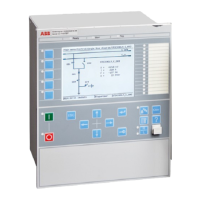different IEDs. If the functions are located in different IEDs they must communicate via GOOSE
interbay communication on the IEC 61850 communication protocol. Complete exchange of
TR8ATCC data, analog as well as binary, via GOOSE is made cyclically every 300 ms.
The busbar voltage U
B
is measured individually for each transformer in the parallel group by its
associated TR8ATCC function. These measured values will then be exchanged between the
transformers, and in each TR8ATCC block, the mean value of all U
B
values will be calculated.
The resulting value U
Bmean
will then be used in each IED instead of U
B
for the voltage
regulation, thus assuring that the same value is used by all TR8ATCC functions, and thereby
avoiding that one erroneous measurement in one transformer could upset the voltage
regulation. At the same time, supervision of the VT mismatch is also performed. This works
such that, if a measured voltage U
B
, differs from U
Bmean
with more than a preset value (setting
parameter
VTmismatch
) and for more than a pre set time (setting parameter
tVTmismatch
) an
alarm signal VTALARM will be generated.
The calculated mean busbar voltage U
Bmean
is shown on the local HMI as a service value
BusVolt under Main menu/Test/Function status/Control/
TransformerVoltageControl(ATCC,90)/TR8ATCC:x.
Measured current values for the individual transformers must be communicated between the
participating TR8ATCC functions, in order to calculate the circulating current.
The calculated circulating current I
cc_i
for transformer “i” is shown on the HMI as a service value
ICIRCUL under Main menu/Test/Function status/Control/
TransformerVoltageControl(ATCC,90)/TR8ATCC:x.
When the circulating current is known, it is possible to calculate a no-load voltage for each
transformer in the parallel group. To do that the magnitude of the circulating current in each
bay, is first converted to a voltage deviation, U
di
, with equation
122:
EQUATION1869 V1 EN-US (Equation 122)
where X
i
is the short-circuit reactance for transformer i and C
i
, is a setting parameter named
Comp
which serves the purpose of alternatively increasing or decreasing the impact of the
circulating current in TR8ATCC control calculations. It should be noted that U
di
will have
positive values for transformers that produce circulating currents and negative values for
transformers that receive circulating currents.
Now the magnitude of the no-load voltage for each transformer can be approximated with:
EQUATION1870 V1 EN-US (Equation 123)
This value for the no-load voltage is then simply put into the voltage control function for single
transformer. There it is treated as the measured busbar voltage, and further control actions
are taken as described previously in section
"Automatic voltage control for a single
transformer". By doing this, the overall control strategy can be summarized as follows.
For the transformer producing/receiving the circulating current, the calculated no-load
voltage will be greater/smaller than the measured voltage U
Bmean
. The calculated no-load
voltage will then be compared with the set voltage
USet
. A steady deviation which is outside
the outer deadband will result in ULOWER or URAISE being initiated alternatively. In this way
the overall control action will always be correct since the position of a tap changer is directly
proportional to the transformer no-load voltage. The sequence resets when U
Bmean
is inside
the inner deadband at the same time as the calculated no-load voltages for all transformers in
the parallel group are inside the outer deadband.
Section 13 1MRK 511 358-UEN A
Control
308
Application manual

